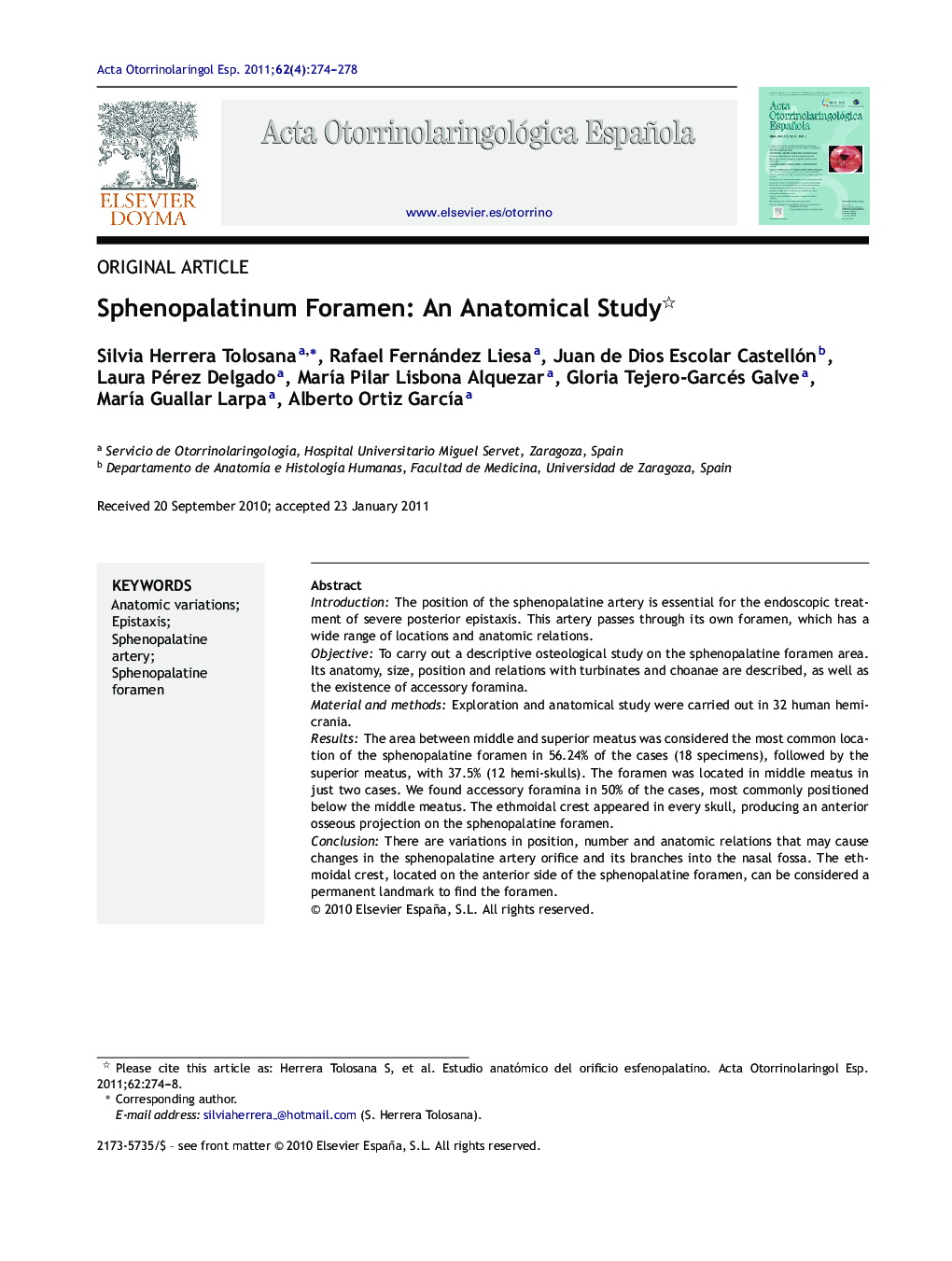| کد مقاله | کد نشریه | سال انتشار | مقاله انگلیسی | نسخه تمام متن |
|---|---|---|---|---|
| 4101218 | 1268752 | 2011 | 5 صفحه PDF | دانلود رایگان |

IntroductionThe position of the sphenopalatine artery is essential for the endoscopic treatment of severe posterior epistaxis. This artery passes through its own foramen, which has a wide range of locations and anatomic relations.ObjectiveTo carry out a descriptive osteological study on the sphenopalatine foramen area. Its anatomy, size, position and relations with turbinates and choanae are described, as well as the existence of accessory foramina.Material and methodsExploration and anatomical study were carried out in 32 human hemi-crania.ResultsThe area between middle and superior meatus was considered the most common location of the sphenopalatine foramen in 56.24% of the cases (18 specimens), followed by the superior meatus, with 37.5% (12 hemi-skulls). The foramen was located in middle meatus in just two cases. We found accessory foramina in 50% of the cases, most commonly positioned below the middle meatus. The ethmoidal crest appeared in every skull, producing an anterior osseous projection on the sphenopalatine foramen.ConclusionThere are variations in position, number and anatomic relations that may cause changes in the sphenopalatine artery orifice and its branches into the nasal fossa. The ethmoidal crest, located on the anterior side of the sphenopalatine foramen, can be considered a permanent landmark to find the foramen.
ResumenIntroducciónLa localización de la arteria esfenopalatina es fundamental en el tratamiento endoscópico de la epistaxis posterior severa. El orificio esfenopalatino, que le da salida, es variable en ubicación y relaciones anatómicas.ObjetivoRealizar un estudio descriptivo osteológico de la región del orificio esfenopalatino, describiendo la anatomía de dicha región, tamaño, localización, relaciones con cornetes y coanas, así como la existencia de orificios accesorios.Material y métodosLa exploración y el estudio anatómico de la zona se llevó a cabo en 32 hemicráneos humanos.ResultadosLa localización más frecuente del orificio esfenopalatino resultó la transición entre el meato medio y superior en el 56,25%, 18 especímenes, seguido del meato superior, 37,5% (12 hemicráneos) y solamente en 2 casos el orificio se abría exclusivamente en meato medio. En el 50% de los casos encontramos la existencia de orificios accesorios, cuya localización más frecuente fue inferior al orificio en el meato medio. La cresta etmoidal se encontraba presente en todos los cráneos estudiados, produciendo un resalte anterior en el orificio esfenopalatino.ConclusiónExisten variaciones anatómicas en el orificio esfenopalatino en cuanto a localización, número y relaciones anatómicas que modificarán la entrada de la arteria esfenopalatina y sus ramas en la fosa nasal. Habiendo encontrado una marca constante localizadora del orificio esfenopalatino, la cresta etmoidal, situada en el borde anterior del orificio.
Journal: Acta Otorrinolaringologica (English Edition) - Volume 62, Issue 4, July–August 2011, Pages 274–278